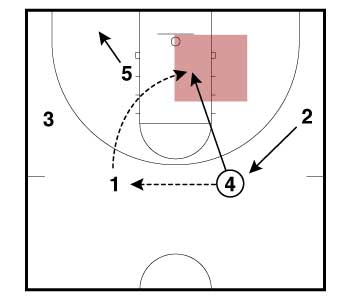I was recently at a Shorter University women’s game watching them dismantle their opponent. This is their first year with the offense, but I noticed one action (or sequence of actions) that they went back to time and again with success.
And, I think you might be able to find a place for it – especially if you do anything in the 4 OUT.
Here’s the whole concept in one frame. 4 (who was their best offensive player) has the ball and the post is on the weak-side. 4 passes to 1, then basket cuts. Instead of trying to hit the cutter right away, 1 lobs over the top into the shaded area.
I’m not exaggerating when I say that this was good for a lay-up two or three times (at the college level, no less) and when it wasn’t, their best player still caught the pass cleanly and then got to work her skills on the low block. Not once did this pass get tipped or thrown out of bounce (of course, your mileage may very on that one, I guess).
Let’s put the defense in to see why this works. On the initial pass, x4 jumps to the ball to deny the give and go. Classic – that’s what most coaches teach. This denial, however, allows 4 to get behind the defender (or at least between the defender and the lob spot indicated by the shaded area).
Answer this: where is the help going to come from?
Since 2 is already high on the wing and now is moving to fill 4’s vacated spot, x2 is in no position to help on the lob. Similarly, x5 is occupied by the weak-side post and even if she tries to recover she’s still on the wrong side of the lob.
I know what you’re thinking. This is too simple to work. Trust me… it’s not. The only way to mess this up is with a bad pass. And, if x5 starts to cheat, then a quick post feed from 1 to 5 will make her pay for it.
PS: If I had a player that could jump out of the gym, I would lob this pass to the rim for the crowd energizing alley-oop. And, if it worked, I would do it possession after possession until the defense figured out how to stop it.
The above diagrams were powered by FastDraw.








